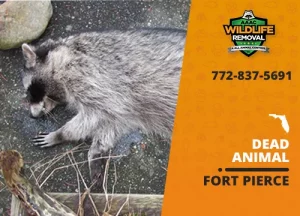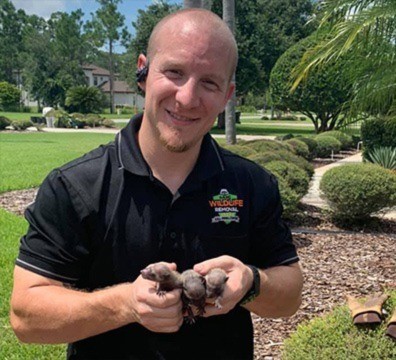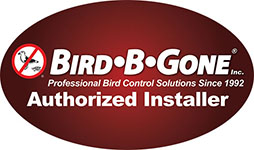The problem with dead animals inside walls is that they stink so bad and the smell will not go away until the carcass is removed. The longer it stays there, the worse the smell gets. You may also have flies and other bugs drawn to the carcass, which can lead to even more problems.
In addition, some species of animals carry diseases that can infect humans when they come into contact with their remains.
The professionals at AAAC Wildlife Removal of Fort Pierce have all the proper equipment and training to rid your home of the animal remains. We will remove the dead animal safely and quickly, so you can go back to living your life without the stench of a dead animal in your home or business.

Dead Animal Removal
Removing animal carcasses from walls and attics is a mucky and uncomfortable procedure. Animal carcasses not only release terrible odors, but their decay can also lead to the spread of viruses and bacteria.
Animal remains left unattended can pollute your soil and water sources that might infect your livestock with harmful pathogens. Diseases and parasites harbored by dead wildlife can infect your pets such as cats and dogs, which can spread to you.
They also attract other infestations such as pests, rodents, and insects that can cause further problems.
How Animals Die Around Your House?
It isn’t rare to find dead wild animals around your houses, such as raccoons, snakes, opossums, or skunks. How did they get there? Well, there are plenty of ways. Some of them are:
Dying animals seeking shelter
If an animal is sick, injured, or dying, it may seek refuge in a home or structure. Usually, wild animals go in narrow and dark places, such as attics, crawlspaces, and wall voids. Once they are inside the home or building, they may not be able to find their way back out and will die from lack of food or water. Dehydrated animals that have been poisoned might lead them to look for water in your basement water pipes and contaminate them.

Wild animals caught in traps under the house
Homeowners sometimes leave traps under their homes and forget about them. Animals like skunks and opossums might be caught in these traps and die there, away from the prying eyes of humans. The decaying bodies will release terrible odors that can seep into your living spaces if you don’t clean them up immediately.

Your pet brought it in
Pets are known to play with their prey, and if they catch something like a small rat or bird, they’d usually bring it home. This can lead to the animal carcass being left somewhere inside your home where it will start to decompose and produce an odor.
Animal got stuck
Some animals, get stuck or crawl into narrow or tight places in your home and are unable to escape. For example, when rats or other small animals explore your home and fall into a wall cavity and can’t climb back up, they will eventually die from the lack of food or water.

Removing mother from her young
Another reason why you may find dead animals around your house is when a mother has been removed from her young. This is usually the case for DIY animal removal attempts. When you remove the mother without bringing the babies along, they will die of dehydration or starvation.
Common Dead Wildlife in a House
- Dead rats, or mice in the attic.
- Dead birds in your vents.
- Dead opossums in your crawl space
- Dead raccoons in your chimney, attic, or garage.
- Dead skunks under your porch or deck.
- A dead animal in front of your home

Dead Wildlife in Attic
The attic is one of the most common places to find dead wildlife. This is because attics are dark, warm, and offer plenty of hiding places for animals. Dead mice and rats in the attic may smell right away, and when these animals start to decompose inside your walls or ceiling, the smell will become even worse. The decaying animal carcasses can also attract other pests, such as cockroaches, maggots, and flies.

Dead Animals in Walls
When an animal dies inside the walls of your home, it can be a difficult task to find and remove it. The smell will start to spread throughout the house and become more intense as time goes on. This usually requires a professional to pinpoint the location of the carcass to remove it without tearing down too much wall.
Animal carcasses that remain for many days can cause several problems, including structural issues, mold and mildew growth, and horrible odors.

Dead Animal in Crawl Space
A dead animal in a crawl space is a homeowner’s nightmare. These spaces are hot and humid and offer the perfect environment for bacteria and mold to grow. Not only will you have to contend with the smell, but you’ll also have to deal with the health hazards that come along with it.
Removing a dead animal from a crawl space can be difficult because of the tight access. It’s important to call in a professional who has the experience and right equipment to find the carcass and dispose of it properly.
How Long Will a Dead Wildlife Smell?
Among the most unpleasant odors in nature are those released by decaying animals. And depending on the size of the animal, the smell will usually last anywhere from a week to a month.
The smell stays for as long as the remains are decaying. It will disappear when the carcass has completely dried out.
How to Find a Dead Wildlife?
It can be quite daunting to try and find a dead animal inside your home when you have no idea where to look. There are a few things you can do to narrow down the area where it’s likely to be.
1. Locate the area where the smell is strong.
A good way to find a dead animal is to track the smell. The stronger the smell the closer you are to the carcass.
2. Check for swarm flies.
Seeing flies inside your house or around it is a sign that there’s something dead nearby. Flies can sense the smell from a long distance and will be the first to arrive at the scene. They are a great sign to find animal remains in your area.
3. Look out for grease stains or a “juicy spot”.
If an animal died in the ceiling or the wall, you may see a stain or “juicy spot” on your ceiling or walls. This happens when an animal’s body starts to decompose and liquefied remains seep through small cracks in the building structure.

4. Watch out for maggots.
Maggots are fly larvae that feed on dead flesh, and they can be a good indicator of where a dead animal is hidden. If you see maggots falling from the ceiling or crawling on the walls, there’s a good chance that something is decaying right above them.
5. Hire an experienced professional.
Trying to locate a dead animal inside your home is just plain nasty and unpleasant. So for the sake of your health and sanity, it’s best to hire a professional who has gas masks and personal protective equipment to take care of the job.
Do not put your health at risk by trying to find and remove a dead animal on your own. Call in the experts at AAAC Wildlife Removal of Fort Pierce for safe, humane, and affordable dead animal removal services.
Dead Animal Removal Fort Pierce
AAAC Wildlife Removal of Fort Pierce is a professional and licensed wild animal removal company that also specializes in the safe removal of animal carcasses. We have the experience and equipment to find the carcass quickly and dispose of it properly.
Our wildlife technicians will remove the carcass so that you don’t have to deal with the smell and the health hazards.
FAQs
Who will remove dead animals in Fort Pierce, FL?
It depends on where you live. The local sanitation department handles the removal of animal carcass. However, for the best service that includes decontamination, deodorization, and damage repair, we would recommend calling a professional wildlife removal company like ours.
How long does it take to remove a dead animal from wall cavities?
This usually depends on the size of the animal. Smaller animals like mice and rats can be removed within an hour. Larger animals like raccoons might take two hours to remove.
Should I hire an expert?
Yes! Hiring a professional is highly recommended. Removal of decaying animal carcasses inside wall cavities is just not for the faint of heart. You’re going to have to follow the smell which is just plain nasty. It’s also very dangerous and you risk exposing yourself to various pathogens that can cause serious health problems such as the Hantavirus or bacteria like Salmonella.
Professionals have the necessary equipment, including gas masks and personal protective gear, to safely remove the carcass without putting your health at risk.
How are the carcasses disposed of?
Carcasses of animals are disposed of in different ways such as incineration, burial, digesters, rendering, and composting.
Call Us Today!
AAAC Wildlife Removal of Fort Pierce offers wildlife removal services and pest control. We have the experience and knowledge to take care of any animal remains removal situation, large or small. We specialize in the humane removal of wildlife and follow all state and local laws. We also handle bird control, nuisance wildlife trapping, raccoon removal, bat removal, squirrel removal, removal of nuisance animals, rodent control, critter control, removal of snakes, humane nuisance animal removal, we also do animal damage repairs and resolve other wildlife issues.
Any animal nuisance problems that you have can be solved by our Fort Pierce wildlife control company. Call AAAC Wildlife Removal of Fort Pierce today for all your wildlife removal needs!









